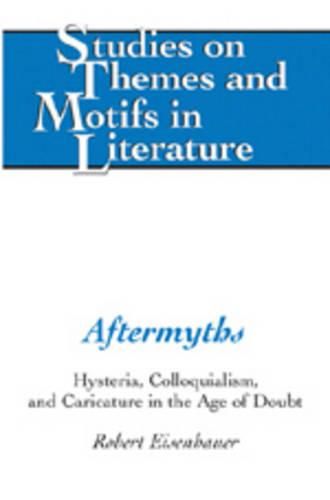Readings Newsletter
Become a Readings Member to make your shopping experience even easier.
Sign in or sign up for free!
You’re not far away from qualifying for FREE standard shipping within Australia
You’ve qualified for FREE standard shipping within Australia
The cart is loading…






Aftermyths investigates fault-lines in literary and visual representation from 1870 to the early twentieth century as they range from a faux essentialism, often with ethnic overtones, to a cadence of decadence reflecting the dissensions of modernity. Reading Henry James and Mark Twain with side-glances to the cartoon revolution of Rudolf Dirks and Richard Felton Outcault, Robert Eisenhauer delves into the archive of frontier or histrionic decadence, Americanness, and Germanness. Pastoral idiom and foreign words, incomprehensible to us as so many dead languages, reflect Hesperian micrology on the part of the Uebergossiper James, a discursive katzenjammer effect, while Twain’s difficulties with German exemplify a strategy of emancipation informed by minstrel-like showmanship and a river or streetwise skepticism. In addition, Eisenhauer applies key concepts of Walter Benjamin’s Arcades Project to New York City after 1920. Mayor Jimmy Walker and urban planner Robert Moses are seen as Dionysian and Apollonian instances contesting the meta-arcades of Manhattan at the intersection of epic, lyric, and drama. Outcault’s Opera in Ryan’s Arcade vernacularizes the difference between uptown and downtown, high art and low un-art. With the premise that Freud’s definition of caricature in Totem and Taboo remains valid, Aftermyths goes on to investigate the bear as a mimetic paradigm for Nietzsche’s not yet determined animal homo sapiens. Finally, Eisenhauer suggests affinities between two fictions of immortality, Grass’s Flounder and Hamill’s Forever, before returning to the downtown scene for remarks on Richard Foreman’s Ontological-Hysteric Theatre.
$9.00 standard shipping within Australia
FREE standard shipping within Australia for orders over $100.00
Express & International shipping calculated at checkout
Aftermyths investigates fault-lines in literary and visual representation from 1870 to the early twentieth century as they range from a faux essentialism, often with ethnic overtones, to a cadence of decadence reflecting the dissensions of modernity. Reading Henry James and Mark Twain with side-glances to the cartoon revolution of Rudolf Dirks and Richard Felton Outcault, Robert Eisenhauer delves into the archive of frontier or histrionic decadence, Americanness, and Germanness. Pastoral idiom and foreign words, incomprehensible to us as so many dead languages, reflect Hesperian micrology on the part of the Uebergossiper James, a discursive katzenjammer effect, while Twain’s difficulties with German exemplify a strategy of emancipation informed by minstrel-like showmanship and a river or streetwise skepticism. In addition, Eisenhauer applies key concepts of Walter Benjamin’s Arcades Project to New York City after 1920. Mayor Jimmy Walker and urban planner Robert Moses are seen as Dionysian and Apollonian instances contesting the meta-arcades of Manhattan at the intersection of epic, lyric, and drama. Outcault’s Opera in Ryan’s Arcade vernacularizes the difference between uptown and downtown, high art and low un-art. With the premise that Freud’s definition of caricature in Totem and Taboo remains valid, Aftermyths goes on to investigate the bear as a mimetic paradigm for Nietzsche’s not yet determined animal homo sapiens. Finally, Eisenhauer suggests affinities between two fictions of immortality, Grass’s Flounder and Hamill’s Forever, before returning to the downtown scene for remarks on Richard Foreman’s Ontological-Hysteric Theatre.